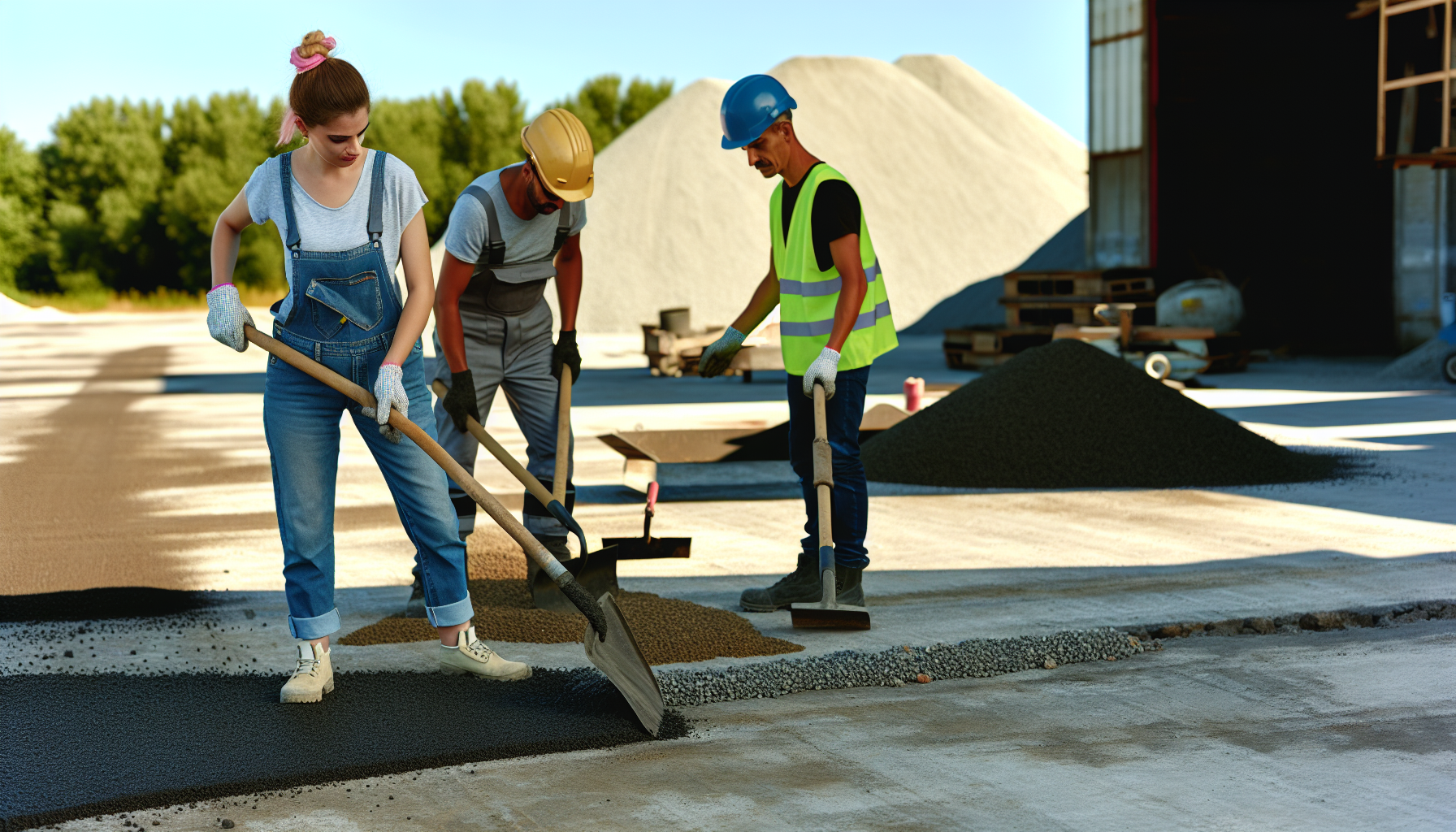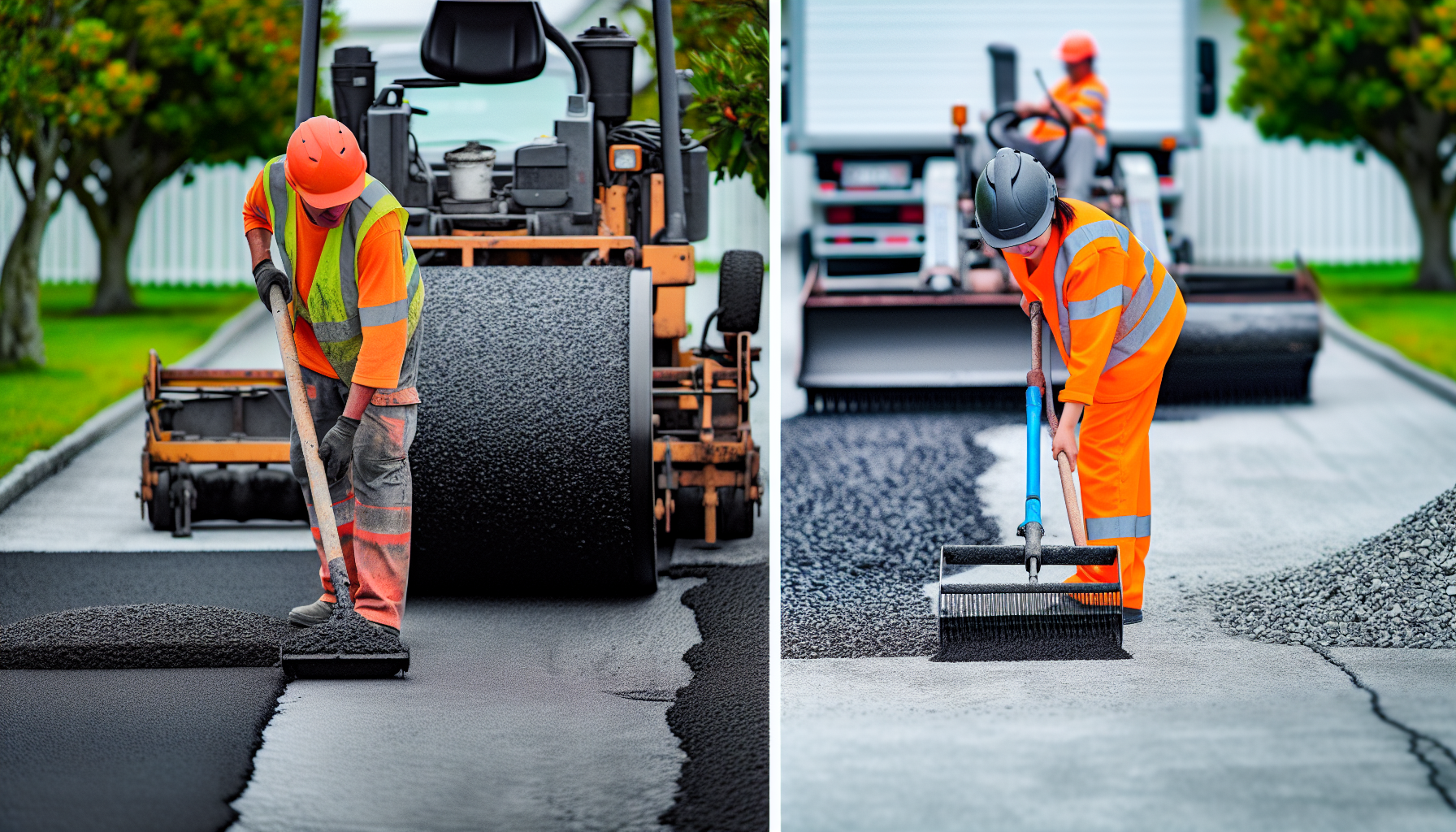Gravel vs. Asphalt Millings - Which One is the Best Option For You?
In the debate of asphalt millings vs gravel for driveways, clear differences in cost, upkeep, and environmental impact emerge. This concise guide dives into those key aspects, giving you the comparative insights needed to make a confident choice for your home.
Key Takeaways
- Asphalt millings offers an eco-friendly, cost-effective, and durable driveway material option with a long lifespan and minimal maintenance, while traditional gravel provides a classic look with more maintenance needs.
- Physical and functional attributes such as weather resistance, aesthetic preferences, and installation costs are important comparison factors between asphalt millings and gravel, with asphalt millings being generally more durable and lower in long-term cost.
- Environmental considerations play a significant role in choosing driveway materials, with asphalt millings being more sustainable due to the reuse of materials, but potential contamination should be checked, particularly in acidic environments.
Understanding Asphalt Millings and Gravel

You might be wondering, what is asphalt? Asphalt millings and gravel are notable materials for constructing driveways, each offering distinct advantages. Produced by pulverizing aged asphalt, asphalt millings present a green choice for driveway building.
In contrast to this, gravel consists of an aggregate mix of rock, sand, and silt without the presence of asphalt binders that characterize the composition found in asphalt millings.
Recycled Asphalt Millings
Asphalt millings, also known as Reclaimed Asphalt Pavement (RAP) or pavement milling, are created by grinding down a bituminous concrete-paved surface. This process, known as pavement milling, yields fine particles composed of bitumen and inorganic material, similar to crushed asphalt. Recycled asphalt pavement serves as an alternative to traditional stone gravel and hot asphalt, providing an eco-friendly solution for various asphalt paving projects.
Employing recycled asphalt millings in road construction and other asphalt ventures conserves natural resources while cutting down on construction debris. This makes asphalt millings a viable option for those seeking to undertake a green initiative in their asphalt paving projects.
Additionally, asphalt millings, being a recycled material from old asphalt, are cost-effective. They reduce the need for new materials, which can be more expensive and less environmentally friendly. Moreover, the fact that asphalt millings become stronger and harder over time, unlike fresh asphalt, adds to their appeal.
Hence, opting for asphalt millings for your driveway or other asphalt projects can be an intelligent, environmentally friendly, and economical choice. It not only helps in resource conservation, but also ensures a robust and durable driveway.
Traditional Gravel
Traditional gravel is composed of an aggregation of small rocks, stones, and sand particles. It’s a common choice for the construction of:
- driveways
- pathways
- garden beds
- drainage systems
The type of gravel chosen for a project depends on its intended use, desired aesthetics, and the specific requirements of the project.
For example, gravel driveways are appreciated for their inherent, rustic allure. They blend effortlessly with most landscapes, adding a touch of authenticity and elegance to the property. Plus, the crunching sound produced when driving over a gravel driveway can add a unique sensory experience.
Nevertheless, one should take into account that gravel driveways might necessitate more upkeep compared to asphalt ones. They may need periodic leveling, cleaning, and refilling with new gravel to maintain their shape and depth. Nevertheless, with proper upkeep, a gravel driveway can be a practical and appealing addition to your home.
Comparing Physical Properties
Comparing the physical properties of asphalt millings and gravel is crucial when deciding on the material for your driveway. These properties can significantly impact the functionality and longevity of your driveway.
Asphalt millings demonstrate strong durability against various weather elements. They get stronger and harder over time, unlike hot asphalt, making them an ideal choice for driveways that endure heavy traffic. However, their durability can vary as they are made from recycled asphalt, which might contain materials of different quality.
On the other hand, gravel driveways provide a non-slip, though rougher, surface. The rough, rocky texture of gravel may pose a threat to fast-moving vehicles, unlike the smoother surface offered by asphalt millings. However, gravel driveways excel in drainage, with their permeability preventing standing water and offering solid traction in wet conditions.
Regarding aesthetics, asphalt millings provide a sleek, uniform driveway appearance, whereas gravel proffers a rustic, natural charm. Hence, your choice between asphalt millings and gravel will depend on your durability requirements, desired surface texture, and aesthetic preference.
Installation Process: Asphalt Millings vs Gravel

The installation process for asphalt millings and gravel driveways involves a crucial step: base preparation. Proper selection and laying of base materials ensure the stability and drainage of your driveway.
A gravel driveway is typically constructed in three layers: a six-inch layer of crushed rock, a middle layer of smaller stones for drainage, and a top layer of rough, angular stones for surface stability. This process may seem daunting, but can be accomplished through a DIY approach for smaller projects. However, for larger projects, machinery might be necessary for leveling, spreading, and compacting each gravel layer.
Conversely, installing an asphalt millings driveway entails spreading the millings across the driveway area and compacting them using heavy machinery for a smooth finish. Although this process can also be undertaken as a DIY project, professional installation is recommended to ensure optimal results.
Cost Analysis: Asphalt Millings vs Gravel
 Cost-wise, asphalt millings and gravel exhibit clear differences that could sway your decision. The initial material cost for asphalt millings ranges between $10 and $20 per ton or $2 to $5 per square foot, while for gravel, it ranges from $10 to $50 per ton.
Cost-wise, asphalt millings and gravel exhibit clear differences that could sway your decision. The initial material cost for asphalt millings ranges between $10 and $20 per ton or $2 to $5 per square foot, while for gravel, it ranges from $10 to $50 per ton.
The installation costs for asphalt millings are typically between $12 and $32 per cubic yard, which includes delivery and installation costs. Thus, even though the upfront costs of asphalt milling might seem higher, they can offer long-term savings due to their durability and minimal maintenance requirements.
On average, an asphalt millings driveway costs between $200 and $1,200, which is less expensive than the average cost for a gravel driveway, ranging from $600 to $1,800. This provides a better perspective on the overall affordability of each material.
Thus, although gravel may appear cheaper initially, asphalt millings could provide long-term savings. Considering the durability, lifespan, and maintenance costs can help you make a more informed decision.
Lifespan and Maintenance

There is considerable variation in the lifespan and upkeep needs of asphalt millings and gravel driveways. With minimal maintenance required, asphalt millings surfaces have an average lifespan ranging from 20 to 30 years. They naturally harden over time, creating a strengthened surface that does not require refinishing, resurfacing, or replacement.
On the other hand, gravel driveways have a considerable lifespan, lasting up to several generations with proper upkeep. However, they may require consistent and sometimes labor-intensive upkeep, including periodic leveling, cleaning, and addition of new gravel. A significant maintenance issue for gravel driveways is their tendency to develop potholes, dips, and grooves from regular use, requiring ongoing maintenance to repair.
Before performing any maintenance on an asphalt driveway it is important to clean the asphalt and remove stains and debris. Next comes crack filling and sealing the asphalt.
Sealcoating driveways with asphalt millings is recommended six months after installation and then every 3 to 5 years to prolong their lifespan. Despite the need for occasional asphalt sealcoating and crack filling, maintenance with asphalt millings are largely maintenance-free, becoming stronger over time, and needing minimal ongoing care.
Ultimately, whether you choose asphalt millings or gravel will depend on your upkeep preferences and long-term driveway plans. If you prefer a low-maintenance option, asphalt millings might be the way to go. However, if you’re ready to invest time in regular upkeep, a gravel driveway could be a good fit.
Environmental Impact
The environmental impact of asphalt millings and gravel also plays a key role in the decision-making process. Both materials have their own set of benefits and drawbacks when it comes to sustainability.
Asphalt millings promote resource conservation by reusing existing asphalt materials, reducing the need for scarce natural resources. This makes them a more eco-friendly option compared to traditional gravel. Plus, the use of asphalt millings can contribute to LEED credits for eco-friendly construction and may qualify for tax credits, reflecting their sustainability benefits.
Nevertheless, be aware that reclaimed asphalt pavement can sometimes release trace elements like lead. Therefore, it is recommended to test reclaimed asphalt pavement stockpiles for releasable levels of metals prior to use, especially in acidic environments.
In contrast, gravel is a natural material that does not involve any form of recycling or potential contamination. Therefore, your choice of driveway material should take into account not only cost and durability, but also the potential environmental impact.
Weather Resistance and Performance
The weather resistance and performance of asphalt millings and gravel are also important factors to consider. Both materials have unique properties that allow them to withstand harsh weather conditions.
Asphalt millings can withstand harsh weather elements, making them a suitable asphalt material, particularly in climates with extreme weather conditions. Their composition allows for greater resistance to cold temperatures, aiding in faster snow melt and reducing the likelihood of ice formation on driveways.
Gravel driveways, on the other hand, are less likely to be damaged by seasonal freeze-thaw cycles and frost heave, thanks to their loose material structure. However, they present challenges during winter, as they are more difficult to plow and clear compared to asphalt millings, with the risk of gravel displacement when using snowplows or snowblowers.
Thus, your local weather conditions, along with the functionality and maintenance you anticipate from your driveway across different seasons, should guide your choice between asphalt millings and gravel.
Aesthetics and Curb Appeal

Driveway aesthetics can notably enhance a home’s curb appeal and possibly boost property value. Both asphalt millings and gravel driveways have unique aesthetic qualities that can enhance the overall look of your property.
Asphalt millings contribute to a clean, consistent asphalt driveway look, offering a polished and modern appearance. The color of asphalt millings can vary slightly depending on the original material that was recycled, adding a touch of uniqueness to your driveway.
On the other hand, gravel driveways offer a rustic, natural aesthetic. They blend well with most landscapes and produce a distinctive crunching sound when driven over, adding a sensory appeal. The type of gravel you choose can also influence the aesthetics of your driveway. For instance, pea gravel offers a variety of colors, while marble chips offer a visually appealing white gravel option that sparkles in sunlight.
Consequently, your personal preference and the overall aesthetic you aspire to for your property will determine your choice between asphalt millings and gravel.
Making an Informed Decision
To make an informed choice between asphalt millings and gravel, it’s necessary to consider their varying characteristics and advantages. Cost-effectiveness, for instance, is a crucial factor. While gravel is typically more affordable upfront, asphalt millings can offer savings in the long run due to their longer lifespan.
A successful and long-lasting driveway aligns with a property’s specific needs. Understanding the differences between asphalt millings and gravel can guide homeowners toward a material selection that aligns with their personal preferences. For instance, if you prefer a smooth, modern-looking driveway, asphalt millings might be the better choice. However, if you prefer a rustic, natural aesthetic and don’t mind the regular maintenance, a gravel driveway could be a good fit.
It’s also important to consider the environmental impact of your choice. As mentioned earlier, asphalt millings are a more eco-friendly option as they promote resource conservation by reusing existing materials. However, they can potentially release trace elements such as lead.
In summary, the ideal driveway material for you hinges on your unique needs, budget, taste in aesthetics, and environmental concerns. It’s always a good idea to weigh all these factors carefully before making your final decision.
Summary
In summary, both asphalt millings and gravel driveways offer unique benefits and considerations. Asphalt millings provide a durable, cost-effective, and environmentally friendly option that requires minimal maintenance. They offer a modern, consistent look and perform well in various weather conditions.
On the other hand, gravel driveways offer a natural, rustic charm and are typically more affordable upfront. However, they require regular maintenance and may not perform as well as asphalt millings in high-traffic areas or extreme weather conditions.
To learn more about the nuances of different materials, read about asphalt vs concrete and asphalt binder vs top coat here.
Ultimately, the best choice between asphalt millings and gravel for your driveway will depend on your specific needs, preferences, and budget. It’s important to weigh all these factors carefully to make an informed decision that will not only enhance the functionality and aesthetics of your property but also offer the best value for your investment. For more information, check out our ultimate guide on asphalt millings here.
Frequently Asked Questions
What are the disadvantages of asphalt millings?
The drawbacks of utilizing asphalt millings consist of the likelihood that dust and dirt may be stirred up from the surface, along with the requirement for intermittent regrading and resurfacing to preserve its state.
How much does 1 ton of asphalt millings cover?
A single ton of asphalt millings can cover an area of 60 square feet to a depth of 4 inches, or alternatively, it can spread over roughly 80 square feet when applied to a thickness of 3 inches.
Is asphalt millings good for driveways?
Certainly, it is possible to compress and mold asphalt millings to form a robust and even surface suitable for both driveways and parking lots.
What are the main differences between asphalt millings and gravel?
Crushing old asphalt generates asphalt millings, an eco-friendly and robust material for driveways. In contrast, gravel consists of a mix of rock, sand, and silt particles and is also utilized in driveway construction.
How do the costs of asphalt millings and gravel compare?
Although the initial expense of asphalt millings might surpass that of gravel, their robustness and reduced upkeep requirements can lead to considerable cost savings over time. Consequently, for a range of uses, they represent an economical choice.


